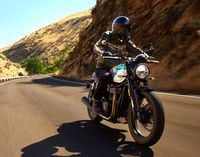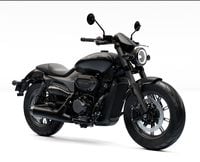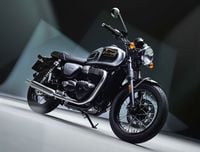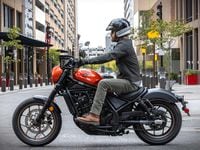Whenever a new tire is mounted, the wheel should be dynamically balanced. However, if you’re doing it yourself that might not always be an option. Here’s the quick and dirty way to static balance your wheels.
Make sure the wheel is free to spin with no drag on it, if you're balancing the front wheel, you can usually just unbolt the caliper(s) and, if need be, the speedometer cable. If it's the rear tire, you'll have to remove the chain or belt as well. If you've got a shaft, or it's too much hassle to remove the rear drive, you'll need to build or buy a balance stand to support the rear wheel. With a little imagination a serviceable one can be carved out of 2x4s or angle iron.
Allow the wheel to rotate slowly pulled only by its own weight. If it won't move on its own, rotate it 90 degrees. If it still won't rotate it's either in balance or there's some drag on it.
Assuming it's not in balance and there's no drag on it, give it a light spin, the wheel doesn't have to complete a dozen revolutions, put it should rotate a time or two. The wheel should come to rest with the heaviest spot at the bottom. Most of the time this will be the valve stem portion of the tire.
Mark that portion of the tire with a crayon for reference and recheck it, if the same spot returns to the bottom you're ready to add weight. If it doesn't repeat the test, if a different spot comes to the bottom each time, the wheel is in balance.
Add some weight to the spot opposite your heavy spot, how much takes some feel. If the wheel moved very slowly towards the heavy spot maybe a 1/4 of an ounce, if it moved quickly maybe 3/8 to a half. You can use solder, stick on or spoke type weights. If you use stick on weights use some masking tape to hold the weight in place until you're sure it's the correct amount, before permanently sticking it to the rim.
Repeat step #4, if the wheel returns to the heavy spot add a little more weight to the light spot. If it comes to rest at the original light spot remove a little weight. If it comes to rest at a random spot, retest. If it comes to rest in a random spot each time or if it'll stay in any given position you place it in (presuming there's no drag), then it's in balance.
By the way, because their balance is affected by the driveline, rear wheels, are as a rule somewhat less sensitive to balance. I'm not saying you shouldn't balance the rear, but I am saying it's not quite so crucial a matter as the front if it's not perfect.
/cloudfront-us-east-1.images.arcpublishing.com/octane/IZANGLHMBG5IXU6K65H62E5S4E.jpg)
/cloudfront-us-east-1.images.arcpublishing.com/octane/OQVCJOABCFC5NBEF2KIGRCV3XA.jpg)
/cloudfront-us-east-1.images.arcpublishing.com/octane/F3O2DGLA4ZBDJGNVV6T2IUTWK4.jpg)
/cloudfront-us-east-1.images.arcpublishing.com/octane/ZXYQE3MHLFDSPKNGWL7ER5WJ4U.jpg)
/cloudfront-us-east-1.images.arcpublishing.com/octane/RDF24VM7WVCOBPIR3V3R4KS63U.jpg)
/cloudfront-us-east-1.images.arcpublishing.com/octane/W7RSIBFISNHJLIJESSWTEBTZRQ.jpg)
/cloudfront-us-east-1.images.arcpublishing.com/octane/AERA26ENRNBW3K324YWCPEXYKM.jpg)
/cloudfront-us-east-1.images.arcpublishing.com/octane/YWX3YX7QBBHFXFDMEEEKRG4XJE.jpg)
/cloudfront-us-east-1.images.arcpublishing.com/octane/I7OKI53SZNDOBD2QPXV5VW4AR4.jpg)
/cloudfront-us-east-1.images.arcpublishing.com/octane/IH52EK3ZYZEDRD3HI3QAYOQOQY.jpg)
/cloudfront-us-east-1.images.arcpublishing.com/octane/K2FSAN7OWNAXRJBY32DMVINA44.jpg)
/cloudfront-us-east-1.images.arcpublishing.com/octane/G4XK7JL24FCUTKLZWUFVXOSOGE.jpg)
/cloudfront-us-east-1.images.arcpublishing.com/octane/JJNXVAC27ZCDDCMTHTQZTHO55Y.jpg)










/cloudfront-us-east-1.images.arcpublishing.com/octane/3VSTLPKOHNFTRJTIAAXDPGCPA4.jpg)
